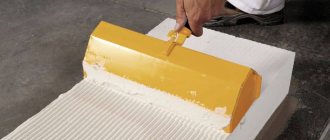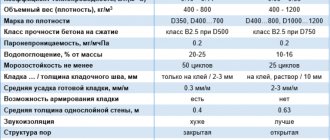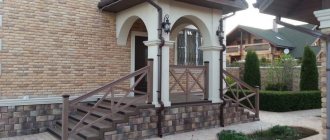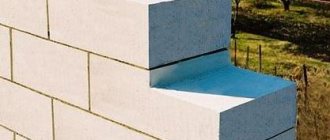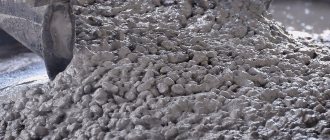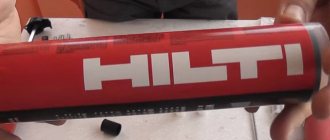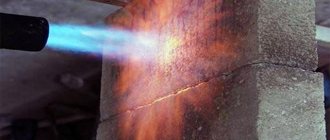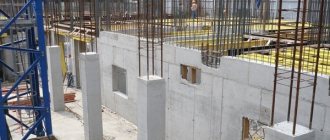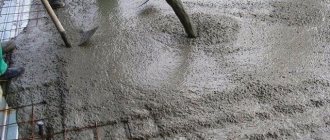Epoxy glue-adhesive for concrete
Epoxy glue application
Designations according to classification
Epoxy glue application
Mapei eporip mixture consumption
1. Epoxy resin ED-20 in an amount of -100 (parts by weight).
2. Plasticizer in the form of SKN-10 rubber in an amount of 10 (parts by weight).
3. Solvent R-4 in an amount of 10 (parts by weight).
4.Hardener Polyamine AF-2 in the amount of 6 (parts by weight).
1.Epoxy resin ED-20 in an amount of 100 parts by weight.
2. Solvent R-4, in an amount of 10 parts by weight.
Types of compositions and the advisability of their use
3. Hardener Polyethylene in an amount of 12 parts by weight.
4. Surfactant (surfactant), grade OP-7, in an amount of 2 parts by weight.
Concrete is an irreplaceable material. To work with it, it is necessary to use high-quality equipment, adherence to working technologies, use of qualified labor and, of course, the selection of reliable and modern adhesive mixtures.
Step 1: Two basic steps for concreting
There are different adhesives on the market today for working with concrete. All of them are ready-made mixtures, which include additives, fillers, and cement itself.
Kawabanga! Leveling concrete mixtures
Application
- Clear the surface of debris.
- Clean the surface well. It is better to remove the top layer altogether, as it is fragile and peels off.
- Prepare the adhesive. If necessary, mix concrete adhesive with hardener. Calculate approximately how much is needed for work, since the time of use is limited.
- Glue. You can apply the glue with a spatula or brush, and immediately place the building material on top.
If the concrete is not 6 months old, then working with the adhesive is prohibited, as it may settle. Sometimes it is necessary to remove the top layer of concrete coating and then carry out gluing. Before the procedure, drywall and plastic must be washed with a mixture of soda and water. The construction market offers a wide range of adhesive products, but you must pay attention to the manufacturer and expiration date. The quality of the work performed depends on this.
How to glue other materials to concrete
Fastening polystyrene foam, polystyrene foam, penofol and penoplex
Materials such as polystyrene foam, expanded polystyrene, penofol and penoplex are intended for insulating the external walls of a house, therefore, in order to glue them to its concrete surface, it is necessary that the adhesive meets the following characteristics:
- withstands temperature changes;
- hardened quickly;
- did not contain solvents that would dissolve the insulation surfaces;
- glued securely;
- was easy to use.
Birss concrete contact consumption during house construction or renovation work can be read in the article.
Read also about what kind of glue is needed for polystyrene foam.
Selecting a binder for plastic, plastic and PVC panels
For gluing plastic to the concrete surface of the ceiling, the multi-purpose “Moment Germent” is well suited, which can properly glue these two surfaces.
Plastic is connected to concrete using conventional Titan construction adhesive, which has excellent adhesion and moisture resistance.
Also, “Liquid Nails” are well suited for gluing plastic surfaces with cement. This glue can be purchased in the form of a dry mixture, which consists of cement and polymers.
Kawabanga! Lithium impregnations – protection of concrete to the entire depth of the screed
In construction, it would be useful to know about concrete GOST 26633 2012.
Wood, laminate, plywood, parquet and sandwich panels
Ruberoid
Metal with stone
Even such incompatible materials can be glued. A two-component epoxy composition can act as their reliable binder. It contains:
- a mixture of epoxy resin with filler and plasticizer;
- combination of thixotropic additive and hardener.
In this article, you can emphasize for yourself which foundation is suitable for a house made of aerated concrete.
To obtain glue, these two components are mixed immediately before construction work and applied to the prepared surfaces.
Linoleum and glass with concrete
Anyone who wants to build a house for themselves from a durable material such as concrete, it will be important to know about all the pros and cons of aerated concrete blocks.
Hardboard
It will be interesting to read an article about the differences between foam concrete and aerated concrete.
For such critical work, you can also use “KS-3” construction adhesive or “Kn-3” rubber mastic.
Tricks of gluing with isolon and foil
It is important to know the difference and what is better: aerated concrete or foam concrete.
For ceramic and tiles
Also read about what adhesive for drywall should be.
Purpose
In modern construction, the technology of constructing walls from block structures is widely used. To connect them, a special adhesive base with special characteristics and structure is used. Using this composition, you can securely fasten any structure to a concrete block or glue concrete to concrete.
The following types of adhesives are offered for sale:
- Dry and liquid mixture.
- Consistencies for old and light material.
- Adhesive for brick surfaces.
Before choosing the best option, you need to familiarize yourself with the properties of each composition.
Types of adhesives
Combined solutions are capable of bonding two different surfaces:
- Expanded polystyrene or polystyrene foam.
- Rubber surfaces and concrete.
- Concrete structures with metal products.
Epoxy adhesive
It is capable of creating a thin coating on the concrete surface and promotes good adhesion.
Epoxy adhesive can also be used to join tiles. But after processing, the seams need to be rubbed down.
Furyl glue
Furyl adhesives contain resins of the same name, which can instantly harden under the influence of heat.
The advantages of such compositions include:
- Maximum fixation strength.
- Resistant to moisture.
- Resistance to chemical reagents.
- Protection against corrosive processes.
Adhesive mixtures for blocks
In the construction industry, the technology of arranging walls from blocks is especially popular. Such designs are characterized by low weight and ease of processing.
Kawabanga! Liquid waterproofing for concrete
And in order to build an integral structure on their basis, the following types of adhesive mixtures should be used:
- For expanded clay concrete blocks.
- For gas silicate blocks.
- For foam concrete blocks.
Some builders prefer the classic version of connecting blocks - laying them on a mortar of cement and sand.
Adhesives that work in extreme conditions
A separate category includes adhesive mixtures that are subject to intense overload due to temperature fluctuations or high humidity.
They are in demand when finishing the following structures:
- Swimming pools and hydraulic structures on the site.
- Fireplaces inside the house.
- Warm floor design.
- Public baths and saunas.
In addition to the listed objects, specialized adhesives may be required when carrying out work on the steps of access stairs, which are covered with a layer of ice during the cold season.
Among the large range of adhesives for extreme conditions, the Ceresit mixture is especially popular.
The advantages of Ceresit products include improved adhesive properties and low cost.
Polymer analogues
The curing time is determined by the specific composition and environmental conditions in which construction work is carried out. At favorable temperatures, this process takes a couple of hours.
This polymer analogue is characterized by increased resistance to chemicals, oils and water. It also meets all environmental standards and demonstrates increased adhesive strength.
Manufacturers
| Characteristics | Stamps | |||
| "Osnovit Selform" | "Rusean" | "Volma Block" | "Itong" | |
| Package weight, kg | 20 | 25 | 25 | 25 |
| Air temperature during use | -10/+10 | +5/+30 | +5/+30 | +5/+30 |
| -10/+5 | ||||
| Consumption per 1m2, kg | 8 | 8 | 6 | 1,5—1,6 |
| Seam thickness, mm | 2—5 | 4—5 | 2—5 | 1—3 |
| Water consumption per 1 kg of mixture, l | 0,2—0,22 | 0,2 | 0,25 | 0,2 |
| Block adjustment time, min | 15 | 15 | 10 | 15 |
| Viability of solution, hour | 1 | 2 | 2,5 | 2—3 |
| Total concrete color | Grey | White | White | White gray |
Most often, builders resort to using Ceresit material.
“Ceresit” is considered the best adhesive composition for concrete; “Leader”, “Polyrem”, “Polimen” are also popular. These are representatives of domestic brands. As for foreign products, builders use French adhesives “Seder”, “Findley”, “Bostik”, as well as German “Jovi”, “Knauf”, “Emfi”. To create masonry from cellular concrete, they prefer to use the Monolith adhesive composition.
What is a good glue for rubber?
Rubber glue
88
The so-called 88th glue
, an excellent option for gluing
rubber
. It contains phenol-formaldehyde resin and a rubber mixture. The resin is part of ethyl acetate with nefras, and this compound gives the very water resistance we need.
Interesting materials:
Which is better, a compiler or an interpreter? Which is better quartz vinyl or pvc? What is better varnish or impregnation? What is better laminate or linoleum in the house? What is better ice or Kuled? Which is better M24 or Kar98k? Which is better, router or access point? What is better: an oil radiator or an electric convector? What is better than MDF and chipboard? What is better: mineral wool or expanded clay?
Properties of quality material
A high-quality adhesive for processing concrete products should have the following characteristics:
- Performance properties remain unchanged for 1-4 hours.
- The standard mixture does not form a film within 20 minutes, and the quick-drying mixture does not form a film within 10 minutes.
- The treated surface does not become slippery.
The packaging with the adhesive mixture may contain the following markings:
- C1 (classic composition).
- C2 (adhesive with improved characteristics).
- C2S (a mixture that is not afraid of deformation).
- E (to be stored open).
- F (characterized by rapid hardening).
- G (has a liquid consistency).
Adhesive mixtures for blocks
Today it has become very popular to build walls of houses from various blocks. They are lightweight and very easy to DIY.
Hence the great demand for specially developed formulations:
- Adhesive for expanded clay concrete blocks.
- Mixtures for laying gas silicate blocks.
- Adhesive for foam concrete blocks.
Of course, you can lay any of the above materials in the old fashioned way on a regular cement-sand mortar. But everyone who becomes familiar with the advantages of new masonry mixtures will switch to them without objection.
What features does adhesive for concrete blocks with various fillers contain:
- Low consumption (up to 40 kg of dry mixture per cubic meter of masonry), due to the plasticity of the finished solution and its application with a notched trowel.
- Fast setting of the solution.
- Thin seams increase the uniformity of the masonry, which improves the properties of the finished structure: Strength.
- Sustainability.
- Frost resistance.
- Soundproofing.
- Thermal insulation.
- Great looks.
In addition, in the future you will be pleasantly surprised by the savings in consumable finishing materials.
Interesting! Experienced private developers have always added PVA glue to concrete and cement mortar; this was done at the stage of introducing water into the concrete mixer. This additive significantly increases the plasticity of the solution, its adhesive capabilities, and the strength of the final product.
Liquid nails are one of the options for gluing two surfaces
Connection technology
The main stages of gluing concrete to various materials include identical steps that must be followed to obtain a reliable fastening.
Return to contents
Preparatory processes
Clean the concrete surface from dust and dirt. New surfaces do not require much preparation. Dust is removed with a damp brush. Repair involves cleaning of residual adhesive mixtures. Significant differences require additional leveling with a layer of cement mortar or plaster.
Return to contents
Primer
After priming the concrete, the adhesion of its surface increases.
When gluing concrete to a variety of materials, concrete is primed! The adhesion of the cement surface, which was initially low, increases. There are several types of soil on the construction market:
- universal;
- deep penetration;
- specialized.
It is enough to treat a new concrete slab with a universal primer. Old concrete planes require deep penetration to bind molecular groups that have lost strength. Acrylic primers are the best choice, safe and practical. Polystyrene-based primer is highly toxic and is used only industrially.
Return to contents
Adhesive mixtures
A large number of adhesive compositions are produced for working with various materials. Dry, liquid, intended for specific surfaces ─ the choice is difficult. Concrete planes have a porous structure; universal mixtures are the most suitable option for gluing plastics, rubber, and plywood. If the compounds will be exposed to high humidity and temperature changes, it is better to use products containing deep-impact modifiers.
Ready-made mixtures are used; adhesive compositions are prepared immediately before starting work, strictly following the instructions indicated on the packaging:
- fill the container with water;
- Gradually pour out the dry mixture, stirring evenly to avoid lumps;
- leave to settle for ten to fifteen minutes;
- Stir thoroughly again.
Using a mixer or drill, completely immerse the rotating planes, eliminating splashing of the mixture.
Return to contents
Bonding procedure
Depends on the type of material and purpose of the surface. Smooth plane and tight fit are a guarantee of high-quality connection and durability of use.
Return to contents
When to use
Despite the apparent similarity, the materials have different characteristics and scope of application. Sodium silicate is ideal for high humidity conditions. The product reduces the porosity of concrete, repels water and creates unfavorable conditions for mold. Treated surfaces do not allow moisture to pass through and do not rot.
Due to the “glass effect”, the liquid additive is recommended for use in lining baths and toilets, wells and swimming pools. At high temperatures, the solution with the addition of transparent material acquires heat-resistant properties. The characteristics of the mixture are useful in the construction of chimneys, fireplaces and stoves.
Use in damp environments Source par-torg.com
Adding Tile Adhesive to Cement
The combination of cement and tile adhesive allows you to obtain a solution with a complex composition and enhanced properties. This is usually done to achieve the following results:
- increasing the elasticity of the solution when applied to vibrating substrates subject to shrinkage;
- increasing the moisture resistance of the finished material;
- imparting frost resistance to the mixture;
- optimization of setting parameters.
Professionals often have their own “recipes” for making cement-adhesive compositions. The effectiveness of the finished building mixture is assessed in practice. For example, by introducing tile adhesive along with cement, you can make the solution much more plastic and quickly process large surfaces with it. Also, the combination of two components will improve the physical parameters of the composition, because the tile adhesive contains only high-quality fine sand and other carefully selected ingredients.
Adding cement to tile adhesive
Beginners often believe that when installing tiles, the adhesion to the surface and the durability of the joint can be enhanced by adding an additional portion of cement to the adhesive composition. Similar actions are also taken if there is not enough glue and part of the tile remains unlaid.
Unfortunately, such replacements can lead to deterioration in the quality of the adhesive joint. The fact is that the composition of the tile adhesive is precisely calibrated and selected in accordance with its intended purpose. The material is used to hold tiles and porcelain tiles on horizontal and vertical surfaces.
If you add cement, you can worsen the adhesion and other technical characteristics of the product. The area that will be glued to such a mixture may soon crumble. Only in some cases is it permissible to make such a replacement:
- when sealing small cracks with adhesive;
- when leveling small sections of walls.
What to look for when choosing glue
Plastic panels should serve for a long time and please with an aesthetic appearance, which can only be achieved with the use of high-quality and suitable adhesive. When thinking about how to glue plastic panels to concrete, it is best to choose compounds specifically designed to work with this material. But there are other suitable options that will ensure sufficient reliability of fixation.
What kind of glue should be used to fix PVC panels:
- Become transparent after complete drying, so as not to be noticeable on the finish and not spoil its appearance.
- Demonstrate high resistance to moisture, sudden temperature changes, high/low temperatures.
- It is desirable that it sets quickly.
- It is important to ensure the highest possible quality of gluing.
- The glue must guarantee long-lasting fixation so that the coating does not have to be changed after a year or two.
- When considering the use of glue in a residential area, it must be safe, so toxic compounds with a strong odor are not chosen for these purposes.
- It is desirable that the glue contains antibacterial additives.
Cement adhesive masonry technology
To create a reliable and safe structure using cement adhesive, it is necessary to take into account a number of rules and recommendations:
- Before starting work, the surface to be treated must be cleaned of stains, unevenness or other defects.
- To increase the density of fixation, the blocks should be periodically moistened with water.
- To properly mix the glue solution, it is necessary to add the dry composition to the water, and not vice versa.
- The consistency is thoroughly mixed to avoid the presence of lumps. Then it should stand for a couple of minutes and mix again.
- Since cement adhesive is characterized by rapid setting, in order to avoid unreasonable consumption of material, it should be mixed in small quantities.
